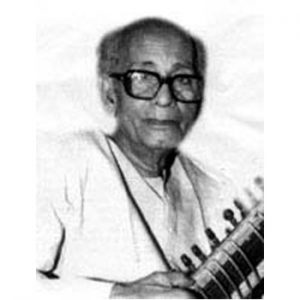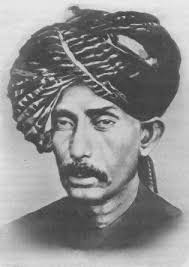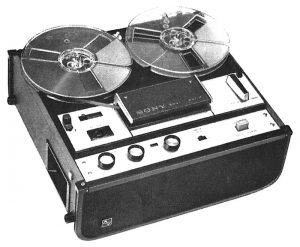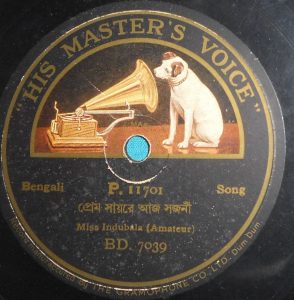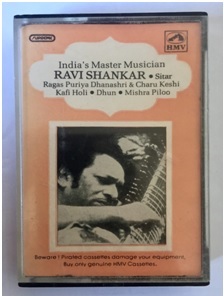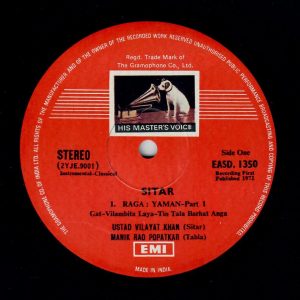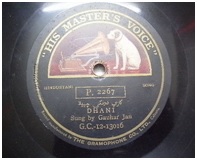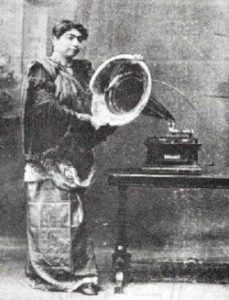| Told by | Sri Jayanta Chattopadhyay |
| Obtained by | Rajeswary Ganguly Banerjee |
| Date | 23rd March, 2017 |
| Place | S.A.P. Lab, Instrumental Department, Rabindra Bharati University, B.T. Road Campus. |
| About the speaker | Renowned Vocalist and Musicologist, Son of Legendary Musician Ustad Vishmadev Chattopadhyay, Bhismadev, |
| Tags | 1933, Vishmadev Chattopadhyay,Bhismadev, Megaphone, Kaji Najrul Islam, Durgadas Bandopadhyay, Lp, Begum Akhtar, Kanan Devi, Fullanolini Dasi, Kalo bala Dasi, Bhabani Das, Natthu Khan, Badal Khan, Suha, Bhairo Bahar, Allauddin Khan, Violin Khan, Bade Ghulam Ali Khan, Sarengi, Kamal Ghosh, Akhtari Bai, Voice Throwing, Mother Disc, J.N.Ghosh, Punjab, Microphone, Recording, Processor, Multani, Pilu, Thumri, Balaram Dey Street |
| Language | Bengali |
Sri Jayanta Chattopadhyay speaks :
Verbatim:
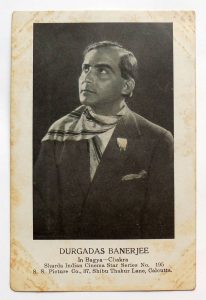
???? ?? ???????? ???????????? ???? ???? ????, ??? ?? ???? ????? ??????? ????? ?? ??? ???? ??????? ??????? ??? ???? ????? ????? ???????-? ??? ???? ??? ???? ?????? ????????? ??? ????????? ????? ???? ????? ????? ????? ????? ??????? ?????? ???? ???? ???? ?????? ????? ???????? ????????? ???? ????? ????? ???????-? ?? ?????? ????????? ??? ??????? ?????? ??? ?????? ?????? ?? ????? ???????? ????? ????????? ???????????????? ?? ????? ???? ???? ????? ???? ??? ?????? ????? ???? ?? ???? ??? ?? ???, ??????? ???? ???? ??? ??, ?? ?? ?? ???? ?? ???? ???? ??? ?????, ????? ??????? ????????? ??????? ????????? ??????????????? ??? ??????? ????? ?? ????? ??? ????? ???????? ????????????? ? ?????? ???? ??? ?????? ??…?? ????????, ??????????? ?????????? ?? ??????????? ??.?? ??? ???????? ????? ??? ?????? ??????, ???????, ??????????? ???????? ?? ??……?? ???????? ??? ???? ????? ??? ??????? ????? ???? ??? ?????? ??? ??? ??????? ???? ?????????? ?????? ????? ??????????? ?????? ???? ??? ????? ??? ??????? ?? ????? ???? ?????? ???? ????? ???????? ???, ???? ????? ???? ??? ????? ??????, ???? ?? ??? ???? ??????? ???, ???? ??????? ????? ???? ???? ??????? ?????? ??? ?????, ???? ????? ?????? ??? ???? ????? ?????? ????? ??? ??? ??????? ???? ??? ?????……???????????? ????, ???????? ???? ??? ??, ??? ??? ??????, ????, ????? ????? ???? ????? ??? ?? ?????????? ???????? ?????? ??? ????? ???? ???? ???????? ?? ????????? ????? ??? ?? ???????, ???? ?? ????????? ???? ?????????? ?? ????? ?????? ?? ?????????? ?? ????? ????? ?????? ???? ???? ?????? ???????? ??? ??????? ??? ??????, ???? ????? ??? ??????? ????…????? ?????? ???? ??????? ??? ??????, ????? ???? ????? ??? ??? ?? ?? ????, ?? ???? ?????? ??????????? ????? ??? ??????? ??? ???? ?? ????????
???? ??? ??????? ????? ?????? ??? ????…?? ???? ?????, ???? ???, ??????-?????, ???? ??? ??????? ?? ??? ???? ??? ??????? ?? ?????? ??? ????? ????? ???????????? ??????? ??????? ????????? ??? ??????? ???????? ?????? ???? ???? ?????? ????? ??????? ???????????????? ?? ?????? ??? ?????? ????????? ??? ???????? ?????? ??? ??? ??????? ??? ???? ????? ??? ??? ????? ?? ??????? ???? ???????, ?????? ????? ????? ??, ???, ???? ????? ???? ???? ?????, ?? ??? ?????? ?????? ?????? ???? ???? ????? ?? ????? ???? ?????? ???, ??? ???????? ?????? ??????, ?????????? ?????? ??????? ?????? ????? ???? ???????? ???? ???? ???????? ??? ?????????? ??????? –? ?? ??????, ??? ???????? ?????? ??? ??? ???? ??????????? ?????? ???? ????? ????? ????? ??? ??? ????? ??????? ????? ??? ??? ??????? ???? ???? ?????? ???????? ???, ???? ????? ??? ??? ???????, ?? ????? ???? ????????, ?????? ???? ?????? ?? ??? ?? ???? ????? ?? ??, ?????? ??? ??? ??? ???? ?? ????? ???? ????? ?????? ??? ?????? ??????? ??? ??????? ??? ???? ??? ??? ????? ?? ?????????? ???? ???? ??? ??????? ?????? ???? ???? ???????? ??? ?? ?? ????? ????? ??? ??? ?????? ??? ?? ??? ????? ??????? ???? ???? ???????? ?? ?????? ????? ??? ??? ??????? ????? ??? ??? ???, ????????? ???? ??? ????, ??? ??? ??? ????? ?? ????? ?? ????? ???? ?????? ??.??.??? ?? ?????????? ??????????? ??? ?? ????? ??? ??? ???? ??????? ??? ???? ???? ???? ?????, ???? ????? ???? ?????, ??? ??? ???? ????? ???? ????? ???? ????? ????? ????? ????? ??? ??????? ?????? ???????-?? ????? ???????? ????? ???????? ?? ??????? ????? ????? ??- ‘?????? ??? ?????? ??????? ???? ???? ??? ??????? ????? ???????, ?? ???? ??? ????? ?? ?????? ??’? ???? ?????? ??, ?? ????? ??? ?? ??? ?? ????? ???? ???? ?????? ??, ??? ?? ??????’? ?? ???? ????? ??-‘??? ???? ??? ??? ???? ????’?
?? ???? ????? ??? ??? ????? ???? ????? ??????, ??? ??? ???????? ?? ???? ???? ?????- ‘? ?? ??????? ??? ??? ????? ??? ???????? ??? ??’? ??.??.??? ??? ??? ??-?? ??? ???? ????? ???? ???? ?????? ??? ??? ???? ????? ‘??? ??????? ??? ?? ??? ???? ???? ??? ?? ???????????’? ???? ???? ??????? ?? ??? ???? ???? ??? ???? ??????????? ?????? ?? ??? ???? ???????? ??? ???? ???????? ?????? ??? ??? ??? ???? ???? ?? ???????? ?? ???? ????? ?????????? ?? ?????? ??? ??? ??????????????? ?????? ?? ??? ??? ???? ????? ?? ???? ???? ??????? ??? ????? ??????? ????? ???? ???? ???? ???? ????? ????? ????? ???, ?? ???? ?? ???? ???? ?? ?? ?????? ???? ??? ???????? ????? ?????, ??? ?????? ???? ???? ?????? ???? ???? ??????? ??????? ?????? ??? ??? ?? ???????? ????? ????? ????? ????? ????? ??? ??? ??????? ????? ?????? ???????? ??? ????? ?? ??????? ??????-‘?? ????? ?????, ???? ???? ?? ???? ?????-‘???? ?????? ????’? ?? ???? ?????? ??? ???????? ?? ??? ? ???? ???????? ?????? ???? ???? ??? ???? ???? ?????? ??????? ??? ????? ????????
????? ????? ????????
??, ????? ????? ??????? ???, ???? ?????? ????? ?? ????????? ??????? ?? ?????
???????? ?????
??? ?? ??????? ?????? ???? ???? ?????????-? ???????? ????? ???? ?? ?????? ???? ??? ?? ????? ???? ????? ????? ??????????? ?????? ??? ???? ?????
Verbatim by: Dr. Suranjita Paul
Translation:
In 1933, VishmadevChattopadhyay, that is, my father, he already knew Kazi Nazrul Islam, and he took him to Megaphone. They required a music director-cum-trainer. Nazrul Islam himself was a trainer there. They were bringing out records of songs he had set to tune. So father joined them as a music director-cum-trainer. During that time, Durgadas Bandopadhyay was in the Drama department. So, alongside setting tunes to songs, father had also set tunes for plays – these were called ‘pala’. Durgadas Bandopadhyay would direct these plays and also act in them, and my father would arrange the music. These records sold very well – Nal-Damayanti, Karnarjun. Karnarjun was later recorded as an LP as well. I have seen that. Then there were other plays like Phullara and Mantrashakti. There are so many others as well…my father has arranged the music for Assamese songs…I have seen this in their catalogue. He composed tunes for orchestra music as well.
Then, Begum Akhtar came, and she used to learn from him. Begum Akhtar has sung his tunes – there are records. Kanan Devi recorded songs from there. Then there is Phullara Devi – Phullaranalini Dasi, she was called Kalobala Dasi. There are recordings of Bhabani Das. Bhabani Das was a rejected artist. He couldn’t throw his voice properly. My father took up the challenge of training him. He loved such challenges. They brought out a record of Bhabani Das’s songs arranged by my father. There is a single record of the tabla playing of Naththu Khan that Megaphone had brought out at my father’s initiative. He was the one who made Naththu Khan record it.
Badal Khan Sahib has just the one recording…both sides have music – it has Suha and Bhayro-Bahar. That was also supervised by my father. Father also supervised a recording of Allaudin Khan playing the violin. There’s something that no a lot of people know about Bade Gulam Ali Khan. He hails from Punjab. It was Begum Akhtar who brought him here. He knew how to play the sarengi and the harmonium because he had a habit of sangat – accompanying the singer on some musical instrument. He has played the sarengiin many recordings of Begum Akhtar. These records came out from Megaphone. He was paid for this. Kamal Ghosh, the owner of Megaphone, has informed me of this himself.
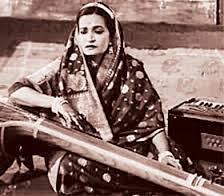
Our Begum Akhtar wanted to bring out a recording of Bade Gulam Ali Khan sahib. She hadn’t then received the title of Begum. She was called Akhtari Bai. But the recording couldn’t get done because he couldn’t throw his voice properly in front of the microphone and the very expensive mother disc was getting damaged. This is in the ‘30s. Bade Gulam Ali Khan was not a big name back then and they were suffering losses, so J.N.Ghosh was not displaying much interest. On the other hand, Begum Akhtar knew that he was a great singer. In the end, she came to father. Father was working in his room at Megaphone’s Harrison Road office. She went there and said, “I brought Khan sahib from Punjab, now these people are saying that they can’t record his songs. They are saying that he cannot throw his voice, so there can be no recording.” Then father said, “Okay, I want to hear him sing.”
So Bade Gulam Ali Khan sahib came into father’s room and sang. After hearing him, father said, “He is a great singer. Why can’t the song be recorded?” So J.N.Ghosh explained that there was some difficulty with voice throwing. Father said that he would show Khan sahib how to throw his voice in front of this particular type of microphone. So he explained it to Khan sahib and they recorded the song again. This time it was better, but not to their complete satisfaction. Father asked them to take a print and make a mother. Then from that copy, you’ll get the actual voice. This is what the technologically-sound young man said. This is how Gulam Ali Khan’s first record came out. On one side was the MultaniKheyal ‘HoSahabJamaan” and on the other side was a PiluThumri – “More NayraLaage”. When the record came out, Bade Gulam Ali signed a copy and came to our house to present it to father as a token of his gratitude.
– This was at the Sarkar Lane house?
– No. Father used to live at BalaramDey Street at that time.
– When was this approximately?
– This was the ‘30s. Father joined Megaphone in 1933 and left everything and went to Pondicherry in 1940.
Translated by: Sarbajaya Bhattacharya
Picture Courtesy: Google
https://www.google.com/url?sa=i&rct=j&q=&esrc=s&source=images&cd=&ved=2ahUKEwiw
http://canacopegdl.com/keyword/old-gramophone.html
Edited & Designed: Dr.Suranjita Paul
Data processed at SAP-DRS Lab, Department of Instrumental Music, Rabindra Bharati University.

